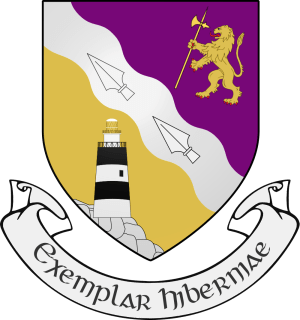Hook Lighthouse facts for kids
| Location | County Wexford, Ireland |
|---|---|
| Coordinates | 52°7′25.7″N 6°55′45.5″W / 52.123806°N 6.929306°W |
| Year first constructed | 1172 |
| Automated | 1996 |
| Construction | limestone tower |
| Tower shape | broad cylindrical tower with double balcony and lantern |
| Markings / pattern | white tower with two black bands |
| Height | 35 metres (115 ft) |
| Focal height | 47 metres (154 ft) |
| Original lens | third order Fresnel lens |
| Range | 23 nautical miles (43 km; 26 mi) |
| Characteristic | Fl W 3s. |
| Ireland number | CIL-0380 |
The Hook Lighthouse (in Irish: Teach Solais Rinn Duáin), also called Hook Head Lighthouse, is a famous tower on Hook Head in County Wexford, Ireland. It stands at the edge of the Hook Peninsula and guides ships into Waterford Harbour.
This lighthouse is special because it's one of the oldest in the entire world. It has been standing for over 800 years! After the Tower of Hercules in Spain, it is the second oldest lighthouse that is still working today. It is managed by the Commissioners of Irish Lights, the group in charge of Ireland's lighthouses.
Contents
History of the Lighthouse

The tower you see today was built in the 12th century. But local stories say that a missionary named Dubhán set up a fire beacon here way back in the 5th century. The Irish name for the area, Rinn Dubháin, means St. Dubhán's Head. The English name "Hook" might come from the similar-sounding Irish word 'duán', which means fish hook.
Who Built the Hook Lighthouse?
The lighthouse was built by William Marshall, a powerful lord in Ireland. He had started a new port in the town of New Ross, about 30 kilometers up the river.
To make his port a success, Marshall needed to make sure ships could get there safely. So, he ordered a 36-meter-high tower to be built at the entrance to Waterford Harbour. We don't know the exact year it was built, but it was sometime between 1201 and 1240.
The first people to take care of the light were a small group of monks. They lit warning fires to help sailors avoid the dangerous rocks. These monks became the very first light-keepers and may have even helped build the tower.
A Look Inside the Medieval Tower
Hook Lighthouse is an amazing example of building from the Middle Ages. The tower is four stories high, and its stone walls are up to 4 meters thick!
Inside, the tower has a winding staircase of 115 steps built right into the wall. The main part of the tower is 13 meters wide at the bottom and has three floors. Each floor still has its original 13th-century stone fireplace. The tower was built using limestone from the local area, and the original building is still standing today.
From Fire to Electricity: The Light's Evolution
For hundreds of years, the lighthouse used different ways to warn ships. At first, monks just lit a big fire, or beacon, on top of the tower.
- 1671: A lantern that burned coal was added to the top.
- 1791: The coal fire was replaced by a huge whale oil lantern that was 12 feet wide.
- 1871: Gas lights were installed. The gas was made right there at the lighthouse.
- 1911: Paraffin oil became the new fuel. A clockwork machine was added to make the light flash. A keeper had to wind it up every 25 minutes!
- 1972: The lighthouse was finally switched over to electricity.
To help sailors in thick fog, the lighthouse also had fog signals. At first, cannons were fired every 10 minutes. Later, a loud horn blasted every 45 seconds during foggy weather.
The Lighthouse Today
In March 1996, the lighthouse became fully automatic. The light-keepers were no longer needed, and the light is now controlled from Dún Laoghaire.
In 2001, the old keepers' houses were turned into a visitor center, and the lighthouse opened for public tours. The fog horn was used for the last time in 2011. Modern ships have advanced technology, so the horn was no longer needed. That same year, the travel guide Lonely Planet called it one of the "Top 10 Flashiest Lighthouses" in the world.
See also
 In Spanish: Faro de Cabo de Hook para niños
In Spanish: Faro de Cabo de Hook para niños
- List of lighthouses in Ireland

